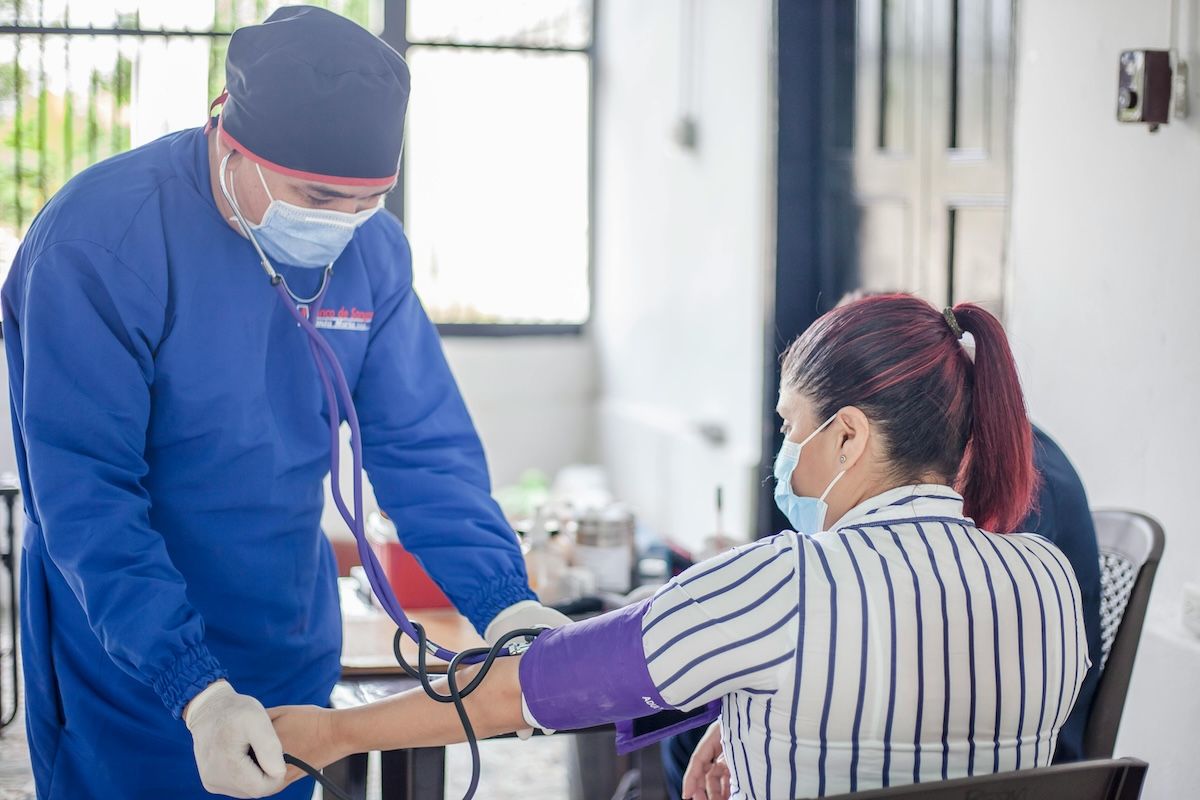How to Become a Physical Therapist – Salary & Requirements for 2026
Globally, 1.71 billion people had musculoskeletal disorders in 2019, with low back pain being the most common condition in many countries (Cieza, A. et al, 2021). The prevalence of these disorders underscores the importance of physical therapy in helping these individuals relieve their pain and recover. This is why physical therapists in the United States (US) have been projected to have a job growth rate of 15% between 2022 and 2032 [US Bureau of Labor Statistics (BLS), 2024].
To help aspiring physical therapists start their careers, I, a career-planning expert with over a decade of experience, created this in-depth guide on how to become a physical therapist. The guide includes essential topics such as scope of practice, earning potential, academic requirements, certification, and the job market.
What are the benefits of becoming a physical therapist?
- Physical therapists in the US had a median annual wage of $99,710 in 2023 (US BLS, 2024).
- Many physical therapists in the US (35%) worked in offices of physical, occupational, and speech therapists as well as offices of radiologists in 2022. Meanwhile, 28% were employed in hospitals in the same year (US BLS, 2024).
- Employment for physical therapists in the US is expected to increase by 15% between 2022 and 2032, which is faster than the average for all US occupations in the same period (US BLS, 2024).
Table of Contents
- What is a physical therapist?
- How much do physical therapists make?
- Where can I work as a physical therapist?
- What are the educational requirements to become a physical therapist?
- What are the required skills for physical therapists?
- Do physical therapist programs offer flexible schedules or online options?
- What is the process to obtain licensure as a physical therapist?
- Do different states have varying licensure requirements for physical therapists?
- What interdisciplinary opportunities exist for physical therapists?
- What career paths are available for graduates of physical therapist programs?
- How can telehealth expand the reach of physical therapy?
- What career paths can physical therapists pursue beyond clinical roles?
- What is the job market for graduates of physical therapist programs?
- Should Physical Therapists Incorporate Public Health Principles to Expand Their Impact?
- How can physical therapists stay current with emerging techniques and best practices?
- How can a complementary pharmaceutical education enhance a physical therapist's practice?
- What opportunities exist for physical therapists to pursue interdisciplinary fields?
- What administrative and coding skills can enhance a physical therapy practice?
- How can leveraging a biology background enhance a physical therapist's career?
- How can targeted healthcare administration training streamline practice operations?
- How can an MHA boost a physical therapist's career?
- Other Things You Should Know about Becoming a Physical Therapist
What is a physical therapist?
Physical therapists are allied health professionals who play a crucial role in helping individuals recover from injuries, surgeries, and illnesses that limit their motion and daily function. They use their expertise in anatomy, physiology, and kinesiology to develop personalized treatment plans for their patients. According to the United States Bureau of Labor Statistics, the number of physical therapists employed in the year 2021 stands at 238,800.
Pursuing a career in physical therapy is more than just a professional decision. The discipline is also a calling to make a positive impact on the lives of others. Physical therapists work with patients of all ages and backgrounds, from infants to the elderly, using various techniques and exercises to help patients recover from physical limitations.
Learning how to become a physical therapist is, in many ways, similar to how to become an NP, and may be the perfect pathway to your personal and professional fulfillment. With a physical therapy degree, the necessary licenses, and a purposeful mindset, you can make a significant difference in people’s lives by helping patients and clients feel better physically and mentally.

How much do physical therapists make?
The annual salary of physical therapists across the US can vary based on several contributors, such as academic achievement, professional experience, and work settings. In 2023, physical therapists in the country had a median annual wage of $99,710 (US BLS, 2024). The figure is much higher than the estimated $53,616 median annual salary of all full-time wage and salary workers in the US in the same year, based on their $1,117 median weekly earnings that year (US BLS, 2024).
Where can I work as a physical therapist?
In 2022, 246,800 physical therapists were employed in the US. Of those, 35% worked in the offices of physical, occupational, and speech therapists as well as the offices of audiologists. Meanwhile, 28% were employed in state, local, and private hospitals. In addition, 10% worked in home healthcare services, 5% were employed in nursing and residential care facilities, and 4% were self-employed (US BLS, 2024).
Notably, physical therapists who worked in home healthcare services had a median annual wage of $107,870 in 2023. Those who were employed by hospitals had $103,690. Physical therapists in nursing and residential care facilities had a median annual wage of $102,810. Moreover, those who worked in the offices of physical, occupational, and speech therapists as well as the offices of audiologists had $93,050 in the same period (US BLS, 2024).
What are the educational requirements to become a physical therapist?
As the demand for healthcare professionals, specifically physical therapists, remains strong, you may want to consider venturing into the field. Physical therapist degree programs are designed to provide you with the education and training necessary to be successful in helping your future patients feel better and recover. The following are the academic requirements to become a physical therapist:
- Bachelor’s Degree. To embark on a career in physical therapy, one must first earn a bachelor’s degree in a relevant field. Although there are no specific majors required, aspirants usually opt for undergraduate degrees in areas such as biology, healthcare administration, and kinesiology. Additionally, pursuing online degrees in public health can prove instrumental in advancing one’s career. Physical therapy-related programs serve as a solid foundation for further specialization in the field. The duration of undergraduate studies varies but generally takes around four years.
- Doctor of Physical Therapy Degree (DPT). A DPT degree is the minimum degree requirement for individuals seeking to get into clinical practice. Compared to how many years of school to be a doctor, which typically takes longer, a DPT program usually requires three years of full-time study, during which students acquire advanced skills in evidence-based practice, differential diagnosis, and therapeutic techniques. The curriculum builds upon foundational undergraduate knowledge and provides a higher level of clinical expertise. Additionally, earning a DPT degree can lead to leadership roles, research opportunities, and increased earning potential within the field.
What are the required skills for physical therapists?
Healthcare professionals in the field of physical therapy work closely with patients to improve their physical and mental well-being. To be successful in helping their patients and clients, physical therapists must develop essential skills. Apart from physical therapist education requirements, which are similar to those of environmental health and safety online degree programs, aspiring physical therapists must gain the following technical and interpersonal skills:
- Anatomy. Anatomy has always been considered vital to healthcare, especially to physical therapy practice (Carroll, M.A., et al., 2021). Physical therapists need to identify and locate specific structures within the human body to evaluate injuries, impairments, or functional limitations to create recovery plans for their patients. Therefore, having a deep understanding of how the human body works is essential for accurate assessment and diagnosis.
- Medical Informatics. Physical therapists receive plenty of information on a patient’s medical background, health challenges, and diagnoses, so health informatics is used to manage the vast amount of necessary information. Healthcare leaders have also recognized informatics competencies as essential in healthcare, especially for evidence-based practices, just like what physical therapists do (Chevan, et. al., 2022). Furthermore, a physical therapist can take an online informatics master’s degree as a specialization. You may also want to check out the best health informatics programs.
- Patient Assessment and Evaluation Skills. Accurate patient assessment and evaluation skills are the foundation for accurate diagnosis and treatment planning. Aspiring physical therapists must possess the ability to understand the specific needs of each patient by performing comprehensive evaluations, including assessing the range of motion, strength, balance, gait analysis, and functional abilities. This diagnosis, in turn, guides the development of personalized treatment plans, so having sound knowledge of patient assessment and evaluation is essential on how to become a physical therapist.
- Communication. Effective communication and interpersonal skills are vital for physical therapists to establish trust, engage with patients, and collaborate with other healthcare professionals (Ahlsen and Nilsen, 2022). They must be able to explain complex medical information in a clear and understandable manner, actively listen to patients’ concerns, and adapt to different communication styles to meet the needs of each individual.
- Problem-Solving Skills. Physical therapy is not a one-size-fits-all approach, as every patient has their own set of needs and challenges. From diagnosing injuries to developing effective treatment plans, they must navigate through complex situations on a daily basis. Problem-solving skills enable aspiring physical therapists to approach different situations with confidence and find appropriate solutions. It is also crucial for physical therapists to create a customized recovery plan that addresses the patient’s specific concerns.
- Empathy and Patience. Recovering from an injury or illness can be a long and challenging journey, and physical therapy is an important part of that process. As a physical therapist, it is essential to remember that patients may feel discouraged or frustrated if they don’t see immediate results. Empathy and patience are key to helping them stay motivated and focused on their recovery.
- Time Management Skills. Lastly, physical therapists must practice effective time management as they navigate the demands of a fast-paced healthcare environment. Given their high caseload, physical therapists must attend to the needs of multiple patients each day. Thus, managing time efficiently optimizes their productivity and ensures that patients receive the appropriate attention and care they require.
Do physical therapist programs offer flexible schedules or online options?
Degree programs in physical therapy typically offer limited flexibility in terms of scheduling due to the hands-on nature of the coursework and clinical experiences required for accreditation. While some programs may incorporate online components for didactic courses or offer hybrid formats, the bulk of the curriculum often requires in-person attendance. This is because physical therapy education emphasizes practical skills and clinical training, which are best learned through direct interaction with patients and supervised practice.
However, in response to the growing demand for flexible learning options, some academic institutions have begun to explore innovative approaches, such as blended learning models, which combine online instruction with on-campus labs and clinical rotations. Additionally, post-professional or continuing education programs may offer more flexibility for practicing physical therapists seeking to advance their skills or specialize in particular areas. Overall, while opportunities for online learning in physical therapy programs are expanding, the profession still primarily relies on traditional in-person education to ensure students develop the necessary clinical competencies and professional judgment.
What is the process to obtain licensure as a physical therapist?
Obtaining certification or licensure as a physical therapist in the US involves several key steps:
- Completion of an Accredited Physical Therapy Program. Prospective physical therapists must graduate from a program accredited by the Commission on Accreditation in Physical Therapy Education (CAPTE). These programs include coursework in anatomy, physiology, biomechanics, and therapeutic interventions, as well as clinical rotations to gain hands-on experience.
- Passing the National Physical Therapy Examination. After graduation, individuals must pass the NPTE, a comprehensive exam administered by the Federation of State Boards of Physical Therapy (FSBPT). The NPTE assesses the candidate's knowledge and skills across various areas of physical therapy practice, including examination, evaluation, diagnosis, prognosis, intervention, and outcomes assessment.
- Obtaining State Licensure. Once the NPTE is successfully completed, candidates must apply for licensure in the state(s) where they intend to practice. State licensure requirements vary but typically include submission of exam scores, educational transcripts, and background checks, as well as payment of licensure fees.
Do different states have varying licensure requirements for physical therapists?
Different states in the US have varying licensure requirements for physical therapists. Each state's licensing board establishes its own set of regulations and criteria for licensure, which can include educational requirements, examination scores, background checks, and additional documentation. While most states require graduation from a CAPTE-accredited program and passing the NPTE, the specific requirements may differ slightly from state to state.
Some states may also have additional requirements such as jurisprudence exams or state-specific laws and regulations related to practice. As such, physical therapists must familiarize themselves with the licensure requirements of the state in which they intend to practice to ensure compliance and eligibility for licensure. Failure to meet these requirements could result in delays or restrictions in obtaining licensure and practicing as a physical therapist in a particular state.
What interdisciplinary opportunities exist for physical therapists?
Physical therapy provides a foundation not only for clinical roles but also for interdisciplinary opportunities that allow practitioners to broaden their scope and impact. For instance, physical therapists can transition into roles that intersect with behavioral science. By acquiring additional certifications, such as a Board Certified Behavior Analyst (BCBA) credential, physical therapists can focus on addressing conditions that involve both physical and behavioral components, such as developmental delays in children or mobility issues linked to mental health challenges.
Enrolling in some of the best BCBA programs offers an excellent pathway for physical therapists interested in applying their skills to behavior-focused therapies. These programs are designed to provide the expertise needed to understand behavioral patterns, implement tailored interventions, and collaborate more effectively within multidisciplinary teams. This knowledge enhances a physical therapist's ability to address comprehensive patient needs.
By embracing interdisciplinary opportunities, physical therapists can advance their professional growth while contributing to a more holistic approach to healthcare.
What career paths are available for graduates of physical therapist programs?
Professionals who have been trained as physical therapists can explore similar roles, including those of chiropractors and occupational therapists. These jobs work with clients and patients, providing them with the necessary treatment plans to relieve their pain and improve their mobility, among other outcomes.
- Physical Therapist. As licensed healthcare professionals, physical therapists diagnose patients and create individualized care plans for them. Their plans include stretching, exercises, and therapeutic equipment to reduce pain, improve mobility, and avoid future injury.
- Physical Therapist Assistant and Aide. Physical therapist assistants and aides (PTAs) work closely under the direction and supervision of physical therapists to help patients improve their quality of life. They work with patients of all ages who have injuries or health-related conditions that limit their ability to move and perform daily activities.
- Chiropractor. Chiropractors have been trained to diagnose and treat musculoskeletal disorders, mainly through manual adjustments of the spine and joints. In 2023, chiropractors in the US had a median annual wage of $76,530 (US BLS, 2024).
- Occupational Therapist. Occupational therapists assist individuals in developing, recovering, or maintaining the skills needed for daily living and working. They usually work in hospitals, schools, and nursing homes. In 2023, occupational therapists in the US had a median annual wage of $96,370 (US BLS, 2024).
How can telehealth expand the reach of physical therapy?
Telehealth represents a transformative opportunity for physical therapists to provide remote consultations, monitor patient progress digitally, and conduct virtual rehabilitation sessions. This approach not only improves access for individuals in underserved or rural areas but also offers a flexible modality that can complement traditional in-person treatments. By integrating secure digital platforms and data-driven monitoring tools, practitioners can enhance treatment adherence and optimize outcomes without geographic constraints. Adopting telehealth requires an investment in technology skills and a comprehensive understanding of digital patient management. In parallel, acquiring advanced business and administrative training—such as via a cheap online MBA healthcare administration—can further strengthen the capabilities needed to manage and expand telehealth services effectively.
What career paths can physical therapists pursue beyond clinical roles?
While many physical therapists (PTs) work directly with patients, there are numerous career opportunities that extend beyond clinical practice. These roles offer variety, potential for higher income, and the ability to impact healthcare in different ways. Here are some options:
- Research and Academia: PTs interested in the scientific and educational side of the field can move into research or teaching. Academic roles include teaching in universities or conducting research on rehabilitation techniques, patient outcomes, or physical therapy innovations. This path may require advanced degrees, such as a Ph.D.
- Specialized Roles: Physical therapists can choose to specialize in specific areas, such as sports therapy, pediatrics, neurology, or geriatrics. Specialization can lead to higher-paying opportunities and the ability to work in niche settings, such as sports teams, rehabilitation centers, or academic institutions.
- Health and Wellness Coaching: Many PTs expand their careers to include wellness coaching. They help clients develop fitness programs, prevent injuries, and adopt healthy lifestyles. This role broadens the PT's impact by helping people maintain overall health, not just recover from injuries.
- Management and Leadership: Experienced physical therapists may move into leadership roles within hospitals, rehabilitation centers, or private practices. These roles involve managing teams of therapists, developing care strategies, and overseeing patient treatment programs.
- Telehealth: The rise of telemedicine has opened new doors for PTs. Through telehealth, physical therapists can conduct virtual consultations, guide patients through exercises remotely, and offer rehabilitation advice. This allows for greater flexibility and broader access to care.
- Consulting: PTs with extensive experience may become consultants, offering advice to healthcare organizations, law firms, or insurance companies. They can provide expertise in developing patient care protocols, handling rehabilitation claims, or even giving expert testimony in legal cases.
- Entrepreneurship: Some PTs venture into entrepreneurship, opening their own clinics, fitness studios, or wellness centers. Others may create online platforms to offer virtual rehabilitation services or sell health-related products, such as exercise equipment or therapy tools.
- Combining Skills with Imaging: For PTs interested in expanding their skill set, pursuing an online ultrasound tech school might be a valuable option. With this additional expertise, PTs can incorporate diagnostic imaging into their practices, enhancing patient care and broadening the scope of services they offer.
Exploring these career paths not only enhances a physical therapist's professional experience but also allows them to create a meaningful and diverse career in healthcare.
What is the job market for graduates of physical therapist programs?
Physical therapy is a rapidly growing profession that plays a vital role in helping individuals improve their quality of life. As the demand for rehabilitative services continues to rise, physical therapists find themselves at the forefront of a promising career path.
With opportunities to engage in research, education, consultation, and health administration, employment for physical therapists is expected to grow by 15% between 2022 and 2032, which is much faster than the average for all US occupations (US BLS, 2024). Several factors contribute to this current trend, including an aging population, an increased emphasis on preventive care, a growing focus on sports and fitness, and the advancement of medical technology. These factors affirm the stability and growth of pursuing a physical therapist education and profession.
Moreover, the field of physical therapy presents numerous prospects for both personal and professional development. Practitioners have the opportunity to specialize in a specific area of expertise, such as sports medicine, geriatrics, pediatrics, or orthopedics. They can also choose to enroll in health-related doctoral programs to have a greater depth of knowledge and skill in their chosen area, thereby enhancing their value as a healthcare provider. Most importantly, physical therapy is considered to be one of the most enjoyable career paths available, with high job satisfaction for those who pursue it.

Should Physical Therapists Incorporate Public Health Principles to Expand Their Impact?
By integrating public health principles, physical therapists can broaden their clinical impact beyond individual patient care and contribute to community-wide wellness initiatives. This interdisciplinary approach involves understanding health policy, epidemic prevention, and population health management to create effective preventive programs and collaborate with public health leaders. Such a framework not only enhances treatment strategies but also strengthens advocacy for systemic improvements in healthcare delivery. Enrolling in affordable public health masters programs offers a strategic pathway for physical therapists seeking to incorporate these paradigms into their practice.
How can physical therapists stay current with emerging techniques and best practices?
Staying up-to-date with the latest advancements in physical therapy is crucial for maintaining effective treatment methods and providing the best patient care. Continuous professional development allows physical therapists to keep their skills sharp and informed. Here are several ways physical therapists can stay current:
- Continuing education courses: Many states require physical therapists to complete continuing education to renew their licenses. These courses cover the latest techniques, research, and best practices in physical therapy.
- Professional associations: Joining organizations like the American Physical Therapy Association (APTA) offers access to webinars, conferences, and journals that provide insights into emerging trends in the field.
- Attending workshops and conferences: Industry conferences and workshops present opportunities to learn from experts, network with peers, and discover new technologies or methods.
- Reading scientific journals: Regularly reviewing publications like the Journal of Orthopaedic & Sports Physical Therapy helps therapists stay informed about evidence-based practices and research developments.
- Specialization certifications: Physical therapists can pursue certifications in specialties like sports medicine, geriatrics, or pediatrics to enhance their knowledge in specific areas and improve their marketability.
- Online platforms and webinars: Engaging in online learning through platforms like MedBridge or APTA Learning Center allows physical therapists to expand their expertise remotely.
How can a complementary pharmaceutical education enhance a physical therapist's practice?
Integrating pharmaceutical education offers physical therapists an avenue to deepen patient care by understanding medication management alongside rehabilitation. Earning a credential such as a Pharm D degree equips clinicians with insights into drug interactions and pain management strategies that can be critical in tailoring holistic treatment plans. This interdisciplinary approach not only optimizes patient outcomes by aligning therapeutic exercises with pharmacological considerations, but it also facilitates closer collaboration with pharmacy professionals, ultimately streamlining care coordination and medication oversight.
What opportunities exist for physical therapists to pursue interdisciplinary fields?
Physical therapists can explore various interdisciplinary fields that complement their clinical expertise. For instance, they can delve into the realm of genetics, which plays a significant role in understanding the underlying causes of certain conditions and developing targeted treatments. To learn more about such opportunities, individuals can research genetics masters programs that can provide them with the necessary knowledge and skills to make a meaningful impact in this field. By combining their physical therapy background with expertise in genetics or other interdisciplinary fields, professionals can expand their career prospects and contribute to innovative healthcare solutions.
What administrative and coding skills can enhance a physical therapy practice?
Efficient practice management requires integrating advanced administrative and coding competencies to optimize revenue cycles and minimize operational disruptions. Physical therapists can benefit from targeted training in healthcare billing, compliance, and reimbursement strategies to streamline practice workflows. Investing in specialized education—such as enrolling in the cheapest medical billing and coding program—enables practitioners to accurately align clinical services with insurance requirements, reduce claim rejections, and improve financial performance.
How can leveraging a biology background enhance a physical therapist's career?
Physical therapists with a solid foundation in biological sciences can tap into advanced career opportunities that blend clinical expertise with biomedical innovation. Integrating insights from anatomy, physiology, and genetics enables these professionals to collaborate effectively in research environments, clinical trials, and biotech initiatives aimed at refining therapeutic approaches. This dual expertise not only fosters the development of innovative patient care strategies but also opens non-traditional avenues, including roles that explore highest paying biology jobs.
How can targeted healthcare administration training streamline practice operations?
By integrating principles of healthcare management into practice operations, physical therapists can enhance operational efficiency, improve revenue-cycle management, and optimize patient scheduling. Focused training in leadership, strategic planning, and financial analysis empowers practitioners to make informed decisions that directly affect practice profitability. For instance, acquiring advanced skills in budgeting, compliance, and strategic resource allocation—often available via a low cost online healthcare administration program—can help streamline administrative tasks and support sustainable growth.
How can an MHA boost a physical therapist's career?
Yes, earning a master’s degree in healthcare administration (MHA) can be highly beneficial for physical therapists who aspire to take on leadership roles within healthcare settings. An MHA equips professionals with the managerial, financial, and operational skills needed to oversee departments, manage clinics, and contribute to strategic decision-making within their organizations.
For physical therapists, obtaining an MHA through 1 year MHA programs online offers a fast, flexible pathway to acquiring these skills while continuing to work. This degree enables therapists to advance into roles such as rehabilitation services director, healthcare operations manager, or clinic administrator. Additionally, MHA graduates gain a broader understanding of healthcare policies, budgeting, and team management, which can enhance patient care delivery and improve clinic efficiency.
By integrating their clinical experience with healthcare administration knowledge, physical therapists can lead teams, optimize patient workflows, and play a pivotal role in expanding access to therapy services within healthcare systems.
Other Things You Should Know about Becoming a Physical Therapist
How long does it take to become a physical therapist in US?
Becoming a physical therapist in the US typically requires completing a Doctor of Physical Therapy (DPT) program, which takes about three years to finish after completing a bachelor's degree. In total, it usually takes around seven years of education: four years for the bachelor's degree and three years for the DPT program. However, the timeline may vary depending on individual circumstances and educational paths.
What are the pros and cons of being a physical therapist?
Pros of being a physical therapist include the following:
- The opportunity to help people improve their quality of life through rehabilitation and pain management
- Job stability due to increasing demand for healthcare services
- The potential for a competitive salary and benefits package
- A flexible work schedule, with opportunities for part-time or freelance work
- The satisfaction of seeing tangible progress in their patients' health
Cons may include the following:
- The physical demands of the job, such as standing for long periods and lifting patients
- The emotional toll of working with patients who may be in pain or facing challenging recoveries
- Burnout due to high caseloads or administrative burdens
Is physical therapy harder than nursing?
Comparing the difficulty of physical therapy and nursing is subjective and depends on individual strengths and preferences. Both professions require rigorous education and training, but the focus and skillsets differ. Physical therapy typically involves in-depth knowledge of anatomy, movement, and rehabilitation techniques, while nursing encompasses a broader range of medical knowledge and patient care responsibilities. Ultimately, determining which profession is "harder" is best assessed based on personal aptitude and career goals.
Are there specific courses or majors recommended for aspiring physical therapists?
Aspiring physical therapists often pursue undergraduate majors in fields such as biology, exercise science, or kinesiology to build a strong foundation in relevant sciences. Courses in anatomy, physiology, and biomechanics are highly recommended to prepare for the rigors of physical therapy education. Additionally, some programs may require or prefer applicants to have completed specific prerequisite courses related to health sciences or human movement.
What types of clinical experiences and internships are available to physical therapy students during their training?
Physical therapy students have access to a variety of clinical experiences and internships that are integral to their training. These typically include rotations in diverse healthcare settings such as hospitals, outpatient clinics, rehabilitation centers, and nursing homes. During these placements, students work under the supervision of experienced physical therapists, applying their theoretical knowledge to real-world scenarios. They gain hands-on experience in assessing and treating patients with various conditions, developing personalized treatment plans, and using advanced therapeutic techniques. These internships not only enhance clinical skills but also help students build professional networks and gain a comprehensive understanding of different physical therapy environments.
References
- Ahlsen, B., & Nilsen, A. B. (2022). Getting in touch: Communication in physical therapy practice and the multiple functions of language. Frontiers in Rehabilitation Sciences, 3. https://doi.org/10.3389/fresc.2022.882099
- Cieza, A. (2021). Global estimates of the need for rehabilitation based on the Global Burden of Disease study 2019: a systematic analysis for the Global Burden of Disease Study 2019. Lancet. https://pubmed.ncbi.nlm.nih.gov/33275908
- US Bureau of Labor Statistics. (2024, January 26). 39. Median weekly earnings of full-time wage and salary workers by detailed occupation and sex. Labor Force Statistics from the Current Population Survey. https://www.bls.gov/cps/cpsaat39.htm
- US Bureau of Labor Statistics. (2024, April 17). Physical Therapists. Occupational Outlook Handbook. https://www.bls.gov/ooh/healthcare/physical-therapists.htm
- US Bureau of Labor Statistics. (2024, April 17). Chiropractors. Occupational Outlook Handbook. https://www.bls.gov/ooh/healthcare/chiropractors.htm
- US Bureau of Labor Statistics. (2024, April 17). Occupational Therapists. Occupational Outlook Handbook. https://www.bls.gov/ooh/healthcare/occupational-therapists.htm


































